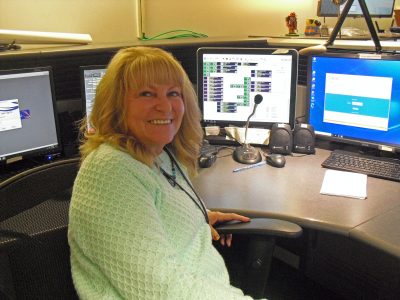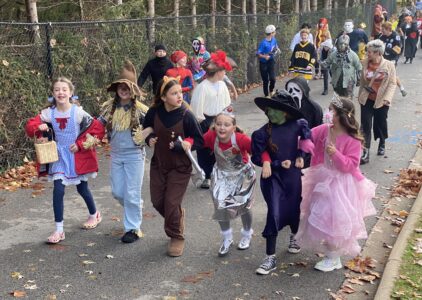When Seconds Matter: Ohio County 911 Dispatchers Trained in ‘Tele-CPR’

Theresa Russell, director of Ohio County 911 (Photo by Nora Edinger)
WHEELING — While TV dramas make it sound like 911 operators can offer instruction on everything from applying a tourniquet to defusing a bomb, the real, local deal said that’s an exaggeration. Sort of.
The truth is West Virginia and a handful of other states (Louisiana, Kentucky, Wisconsin, Indiana, Maryland, Texas and Rhode Island, according to the American Heart Association, or AHA) now have laws that mandate emergency dispatchers offer telecommunicator-CPR (T-CPR) and similar dispatcher-aided medical assistance.
Theresa Russell, Ohio County 911 director, said operators are, as a result, now trained and poised to talk callers through the earliest minutes of CPR. Beginning such resuscitation before an ambulance arrives has been associated with a near doubling of survival rates among those 350,000 some Americans who have sudden cardiac arrest outside a hospital setting each year, according to the AHA.
It doesn’t stop there, Russell added.
Bolstered by a new Computer-Aided Dispatch system, the state’s move toward this uber level of first response (and liability protection for its 911 operators) allows dispatchers to instantly assist callers who need help with choking, overdoses, gunshot wounds and many other medical emergencies. They can also talk people out of a burning building or work to prevent callers from disturbing a crime scene that police and prosecutors need to remain intact.
There’s intensive training and flip cards with scripts that work through various emergency scenarios supporting this, Russell said. There are also five-screen desktops that provide supporting details. These range from which police officers are on duty to the ability to instantly check weapons registered to the individuals involved in the emergency.
Some of the equipment was installed in 2020, when COVID quarantining nearly halved the county’s normal 48,000 annual calls and freed up some valuable time, Russell said.
The new setup is light years away from the phone and pad of paper that she and fellow center veteran Jerry Kulpa — the 14-member team’s designated trainer for this kind of emergency response — remember from when 911 was new to the county in the late 1980s and early 1990s.
Kulpa recalled a time before T-CPR when prayer was all he could offer one woman as he heard her husband’s breathing slow toward death. “There wasn’t anything else I could do.”
SPEED MATTERS
Russell said the rural nature of the state is a primary driver of the law change. Some of West Virginia’s 1.8 million residents have spread into areas that aren’t easy for emergency responders to access and many live outside municipalities with paid fire departments and EMT’s.
“Responders are sometimes slower because they are volunteers,” she said of why it is critical dispatchers have the ability to both collect information and launch immediate assistance.
An example of how critical dispatcher direction can be? “We had a fire in North Wheeling … The caller was located in an upstairs bedroom,” Russell said. “The (dispatcher) was asking questions about, ‘Can you feel the heat?’ ” within seconds.
The dispatcher rapidly had the caller shut the bedroom door, block the gap under the door to prevent smoke from entering and go to a specified window. Simultaneously in contact with firefighters, the dispatcher was able to direct them to that very window, from which they soon safely pulled the caller.
“We stay on the phone with them until law enforcement arrives, especially depending on the information we’re gathering and how bad it is,” Russell said of situations that could also include de-escalation instructions in the case of domestic violence or driving strategies in the case of road rage.
“There’s a lot of assessment with pretty much every call that comes in,” she said.
Kulpa noted that cell phones have added a new wrinkle to 911 dispatching. The region’s signal-shattering topography and the possibility of storms causing a rush of calls that exceed a tower’s capacity can lead to the Wheeling-based center getting calls from Columbus or Greene County, Pennsylvania.
Sometimes, such callers, especially those involved in traffic accidents, don’t know where they are and dispatchers have to use new equipment to locate them by their cell phone coordinates and link them to the place-appropriate responders.
Other times, the proliferation of cell phones may lead to two dozen people calling in a fender-bender, clogging up center lines, Russell noted. In contrast, she said they are sometimes surprised that visible fires elicit only a single call.
PROTECTING THE SCENE
The dispatchers are also now trained to protect emergency and crime scenes, keeping in mind that police or prosecutors may need them to remain intact, she added.
She recalled a tense 13-minute call in which this was a factor. “There was a murder that occurred in Pennsylvania that led into West Virginia.”
Warned by responders from Washington County that an Ohio County family was likely in danger, police were dispatched to a home. But, a family member got to the scene first and called 911 after finding a body and realizing other family members were alive but trapped in the basement.
“Should I go down?” Russell said the caller asked, wanting to release them.
“(The dispatcher) said, ‘No!’ She said, ‘Just yell down and see if they are OK,’ ” Russell said of preserving the crime scene. “You have to think like a law enforcement officer or think like a firefighter.”
Sometimes, the dispatchers’ early intervention even becomes part of law enforcement, she noted.
“One dispatcher asked so many questions (while de-escalating a domestic violence call), by the time they got done they had the offender admitting on the telephone that he had hit his spouse. It’s easy to prosecute that.”
Successes aside, Russell said one of the hardest parts of the job is knowing some limits will always remain, such as when a car is being swept away by floodwaters or when T-CPR isn’t enough.
Even then, she said, she feels the law changes have allowed a good that goes beyond lives saved for both dispatchers and 911 callers.
“There are times there’s just nothing we can do. We know CPR is not going to save everybody,” Russell said. “(But), instead of feeling helpless on the other end of the phone, they feel that they at least tried.”





